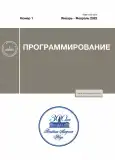No 1 (2023)
DATA ANALYSIS
REAL-TIME ANALYTICS: BENEFITS, LIMITATIONS, AND TRADEOFFS
Abstract
Real-time analytics is a relatively new branch of analytics. A common definition of real-time analytics is that it consists in analyzing data as quickly as possible over the most recent data possible. This defines the essence of the fundamental needs of users, but in no way is a specific requirement for the corresponding software systems due to the vagueness of the definition. As a result, different manufacturers of analytical datamanagement systems and researchers classify real-time analytics systems as extremely different systems, which differ in architecture, functionality, and even timing. The purpose of this article is to analyze the different approaches to providing real-time analytics, their advantages and disadvantages, and the tradeoffs that both system designers and their users inevitably have to make.
 3-31
3-31


COMPUTER ALGEBRA
INVESTIGATION OF DIFFERENCE SCHEMES FOR TWO-DIMENSIONAL NAVIER-STOKES EQUATIONS BY USING COMPUTER ALGEBRA ALGORITHMS
Abstract
A class of consistent difference schemes for incompressible Navier–Stokes equations in physical variables and their differential approximations are considered using an algorithm for Gröbner basis construction. Results of investigating the first differential approximations of these schemes, which are obtained by using the authors' programs implemented in the SymPy computer algebra system, are presented. For the difference schemes under consideration, the quadratic dependence of the error for large Reynolds numbers and the inversely proportional dependence for creeping currents are analyzed.
 32-37
32-37


COMPUTING UNIMODULAR MATRICES OF POWER TRANSFORMATIONS
Abstract
An algorithm for solving the following problem is described. Let m < n integer vectors in the n-dimensional real space be given. Their linear span forms a linear subspace L in R. It is required to find a unimodular matrix such that the linear transformation defined by it takes the subspace L into a coordinate subspace. Computer programs implementing the proposed algorithms and the power transforms for which they are designed are described.
 38-47
38-47


IMPLEMENTATION OF GEOMETRIC ALGEBRA IN COMPUTER ALGEBRA SYSTEMS
Abstract
For describing specialized mathematical structures, it is preferable to use a special formalism rather than a general one. However, tradition often prevails in this case. For example, to describe rotations in the three-dimensional space or to describe motion in the Galilean or Minkowski spaces, vector (or tensor) formalism, rather than more specialized formalisms of Clifford algebra representations, is often used. This approach is historically justified. The application of specialized formalisms, such as spinors or quaternions, has not become a mainstream in science, but it has taken its place in solving practical and engineering problems. It should also be noted that all operations in theoretical problems are carried out precisely with symbolic data, and manipulations with multidimensional geometric objects require a large number of operations with the same objects. And it is in such problems that computer algebra is most powerful. In this paper, we want to draw attention to one of these specialized formalisms—the formalism of geometric algebra. Namely, it is proposed to consider options for the implementation of geometric algebra in the framework of the symbolic
computation paradigm.
 48-55
48-55


ALGORITHM FOR COMPUTING THE TRUNCATION OF THE DISCRIMINANT OF A POLINOMIAL
Abstract
A program that computes the truncation of the discriminant for a polynomial of one variable onto facets of the Newton polytope for the discriminant of this polynomial, as well as enables the factorization of this truncation into the product of discriminants of polynomials of lower degrees, is developed.
 56-60
56-60


A PACKAGE OF PROCEDURES AND FUNCTIONS FOR CONSTRUCTIONS AND INVERSION OF ANALYTIC MAPPINGS WITH UNIT JACOBIAN
Abstract
The set of polynomial mappings of n-dimensional complex space into itself the Jacobian matrix of which has a constant nonzero determinant is known to be very vast in any dimension that exceeds one. The well-known Jacobian conjecture states that any such mapping is polynomially invertible. Even though the computation of the determinant of the Jacobian matrix is very well supported in modern computer algebra systems, the algorithmic inversion of a polynomial mapping is still a problem of considerable computational complexity. In this paper, we present a Mathematica package JC that can be used for construction and inversion of polynomial mappings and more general analytic mappings with the unit determinant of the Jacobian matrix. The package includes functions that allow one to algorithmically construct these mappings for a given dimension of the space of variables and a given degree of mapping components. The package, together with a library of datasets for testing it and results of computational experiments, is available for free public use at https://www.researchgate.net/publication/358409332_JC_Package_and_Datasets.
 61-68
61-68











